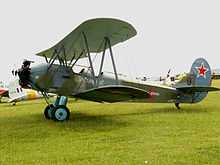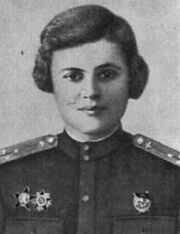Night Witches

"Night Witches" is the English translation of Nachthexen, a World War II German nickname (Russian Ночные ведьмы, Nochnye Vedmy) for the female military aviators of the 588th Night Bomber Regiment, known later as the 46th "Taman" Guards Night Bomber Aviation Regiment, of the Soviet Air Forces. The regiment was formed by Colonel Marina Raskova and led by Major Yevdokia Bershanskaya.
The regiment flew harassment bombing and precision bombing missions against the German military from 1942 to the end of the war.[1] At its largest size, it had 40 two-person crews. It flew over 23,000 sorties and is said to have dropped [2] 3,000 tons of bombs. It was the most highly decorated female unit in the Soviet Air Force, each pilot having flown over 800 missions by the end of the war and twenty-three having been awarded the Hero of the Soviet Union title. Thirty of its members died in combat.[3]
The regiment flew in wood and canvas Polikarpov Po-2 biplanes, a 1928 design intended for use as training aircraft and for crop-dusting, and to this day the most-produced biplane in all of aviation history. The planes could carry only six bombs at a time, so multiple missions per night were necessary. Although the aircraft were obsolete and slow, the pilots made daring use of their exceptional maneuverability; they had the advantage of having a maximum speed that was lower than the stall speed of both the Messerschmitt Bf 109 and the Focke-Wulf Fw 190, and as a result, the German pilots found them very difficult to shoot down. An attack technique of the night bombers was to idle the engine near the target and glide to the bomb release point, with only wind noise to reveal their location. German soldiers likened the sound to broomsticks and named the pilots "Night Witches."[4] Due to the weight of the bombs and the low altitude of flight, the pilots carried no parachutes.[5]
From June 1942, the 588th Night Bomber Regiment was within the 4th Air Army. In February 1943 the regiment was honored with a reorganization into the 46th Guards Night Bomber Aviation Regiment and in October 1943 it became the 46th "Taman" Guards Night Bomber Aviation Regiment.[6] "Taman" referred to the unit's involvement in two celebrated Soviet victories on the Taman Peninsula during 1943.
People


- Commanders
- Yevdokia Bershanskaya—Regimental Commander
- Yevgeniya Zhigulenko, Hero of the Soviet Union—Flight Commander
- Tat'yana Makarova, Hero of the Soviet Union—Flight Commander
- Nina Ul'yanenko, Hero of the Soviet Union—Flight Navigator
- Notable members
- Vera Bjelik
- Rufina Gasheva
- Polina Gelman
- Natalya Meklin
- Nadezhda Popova
- Yevgeniya Rudneva
- Irina Sebrova
- Lilya Litvyak
Exclusively female units
On October 8, 1941, Order number 0099 specified the creation of three women's squadrons—all personnel from technicians to pilots would be entirely composed by women. These were:[7]
- 586 Regiment, Yak-1 fighters
- 587 Regiment, twin engine dive bombers
- 588 Regiment, night bombers
Although all three regiments had been planned to have women exclusively, only the 588th would remain an all-women regiment throughout the war. The 586th fighter regiment had to employ male mechanics as no women had received training to work on the Yakovlev fighter planes before the war. The 586th's woman commander, Major Tamara Aleksandrovna Kazarinova, was replaced with a man, Major Aleksandr Vasilievich Gridnev, in October 1942. The 587th dive bomber regiment was originally under the command of Marina Raskova but after her death in 1942 a male commanding officer, Major Valentin Vasilievich Markov, replaced her. The 587th's PE-2 dive bombers also required a tall person to operate the top rear machine gun but not enough women recruited were tall enough, requiring the addition of some men to join the aircrews as radio operator/tail gunner.[8][9]
Film adaptations
In 1981 a Soviet feature-length film called Night Witches In The Sky (В небе ночные ведьмы) was directed by Evgenia Zhigulenko (Евгения Жигуленко), Hero of the Soviet Union, one of the members of 588.
In 2001 a UK-Russian co-production starring Malcolm McDowell, Sophie Marceau and Anna Friel was due to be made, but failed to get backing from an American studio.[10]
In 2013, a short animation called The Night Witch commemorating Nadezhda Popova, who had died earlier that year, was commissioned in collaboration with The New York Times Magazine's The Lives They Lived issue and directed by Alison Klayman.[11]
There was a film project underway in 2013, to be written by Gregory Allen Howard and financed by the grandson of Boris Yeltsin.[12]
Cultural references
- The Night Witches had appeared in the long-running British comic strip Johnny Red. Writer Garth Ennis, a childhood fan of the strip, would later write a three-part comic book mini-series called Battlefields: The Night Witches[13]
- Another comic where the Night Witches appeared is "The Grand Duke" by Yann and Romain Hugault (Archaia Entertainment, 2012.)[14] ("Le Grand Duc", Paquet 2008)
- Swedish power metal band Sabaton's 2014 album, "Heroes", had a track named "Night Witches". The track is in direct reference to the 588th Night Bomber regiment.
See also
- Washing Machine Charlie, term for Japanese night harassment aircraft during WW II's Guadalcanal Campaign and later
- Charles Carpenter (Lt. Col.), a US Army officer who successfully improvised the use of anti-tank ordnance from an American L-4 Grasshopper artillery observation aircraft.
References
- ↑ "We were called Night Witches" by Rakobolskaya I. V. Kravcova N. F. Moscow:MGU, 2005 ISBN 5-211-05008-8
- ↑ BBC TV
- ↑ Noggle, Anne; White, Christine (2001). A Dance with Death: Soviet Airwomen in World War II. Texas A&M University Press. pp. 20–21. ISBN 1-58544-177-5.
- ↑ http://www.nytimes.com/2013/07/15/world/europe/nadezhda-popova-ww-ii-night-witch-dies-at-91.html?_r=0 New York Times obituary of Nadezhda Popova
- ↑ Axell, Albert (2002). Russia's Heroes 1941–45. Carroll and Graf Publishers. pp. 60–62. ISBN 0-7867-1011-X.
- ↑ (Russian) 65-летие 4-ой Армии ВВС и ПВО
- ↑ Original transcript order 0099 01 10 1941
- ↑ Noggle, Ann (2001). A Dance with Death : Soviet Airwomen of World War II. Texas A&M University Press. ISBN 1-58544-177-5.
- ↑ Bhuvasorakul, Jessica. "Unit Cohesion Among the Three Soviet Women's Air Regiments During World War II" (PDF). Florida State University.
- ↑ Variety Magazine, June 28, 2001
- ↑ New York Times, December 12, 2001
- ↑ Variety Magazine, November 4, 2013]
- ↑ http://www.dynamiteentertainment.com/htmlfiles/c-Battlefields.html Battlefields, Dynamite Entertainment
- ↑ http://goodcomics.comicbookresources.com/2013/08/09/review-time-with-the-grand-duke/
Bibliography
- Cottam, Kazimiera Janina (1998). Women in War and Resistance: Selected Biographies of Soviet Women Soldiers. Newburyport, MA: Focus Publishing/R. Pullins Co. ISBN 1-58510-160-5.
- Milanetti, Gian Piero (2013). Soviet Airwomen of the Great Patriotic War: A pictorial history. Istituto Bibliografico Napoleone, Rome, Italy. ISBN 9788875651466.
- Milanetti, Gian Piero (2011). Le Streghe della Notte: La storia non detta delle eroiche ragazze-pilota dell'Unione Sovietica nella Grande Guerra Patriottica (in Italian). Istituto Bibliografico Napoleone, Roma, Italia. ISBN 88-7565-100-0.
- Pennington, Reina (1997). Wings, Women, and War: Soviet Airwomen in World War II Combat. University Press of Kansas. ISBN 0-7006-1554-7.
- Sakaida, Henry (2003). Heroines of the Soviet Union: 1941–45. Osprey Publishing. ISBN 978-1-84176-598-3.
Further reading
- "Day of Glory for USSR's Night Witches", by Robyn Dixon. Los Angeles Times. May 10, 2001, Part A: Foreign Desk, page A1.
- What They Didn't Teach You About World War II, by Mike Wright 1998 ISBN D39191-649S
External links
- Soviet Women Combat Pilots New Zealand Fighter Pilots Museum
- The Incredible Story of the "Night Witches"
- Female Faces of the Air War
- Russian Women Pilots
- Marina Raskova and Soviet Female Pilots
- The Night Witches - Russian Combat Pilots of World War II
- Airwomen of the Red Star San Diego Aerospace Museum.
- Stalins Himmelsstürmerinnen SPIEGEL story on the Night Witches, in German
- Unit Cohesion Among the Three Soviet Women's Air Regiments During World War II (Master's thesis by Jessica Bhuvasorakul)
- The Glorious Daughter of the Steppe and Brave Hero of the Skies
- The Night Witches: The True Story of an Incredible Group of Women